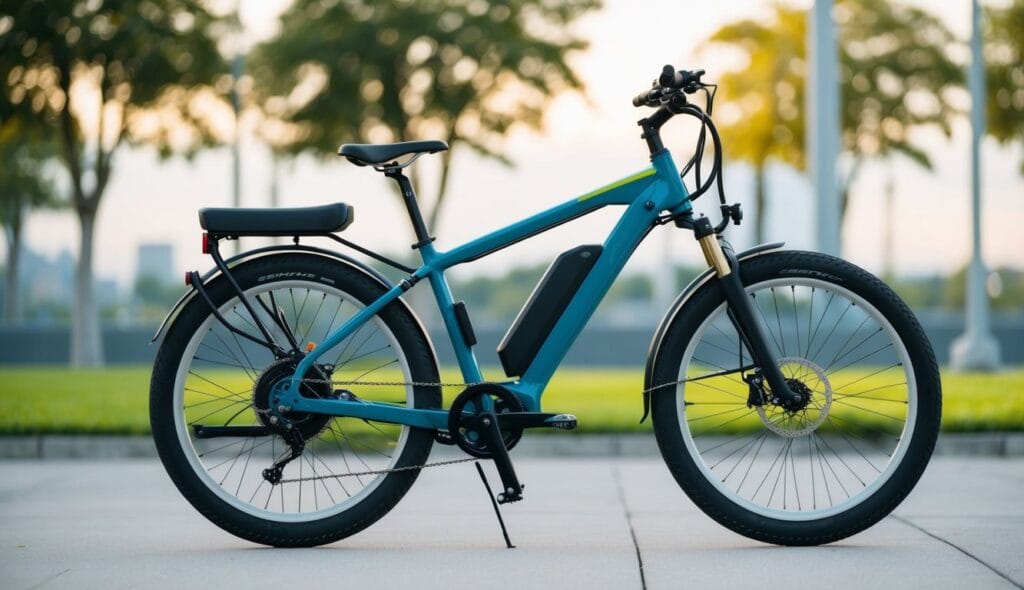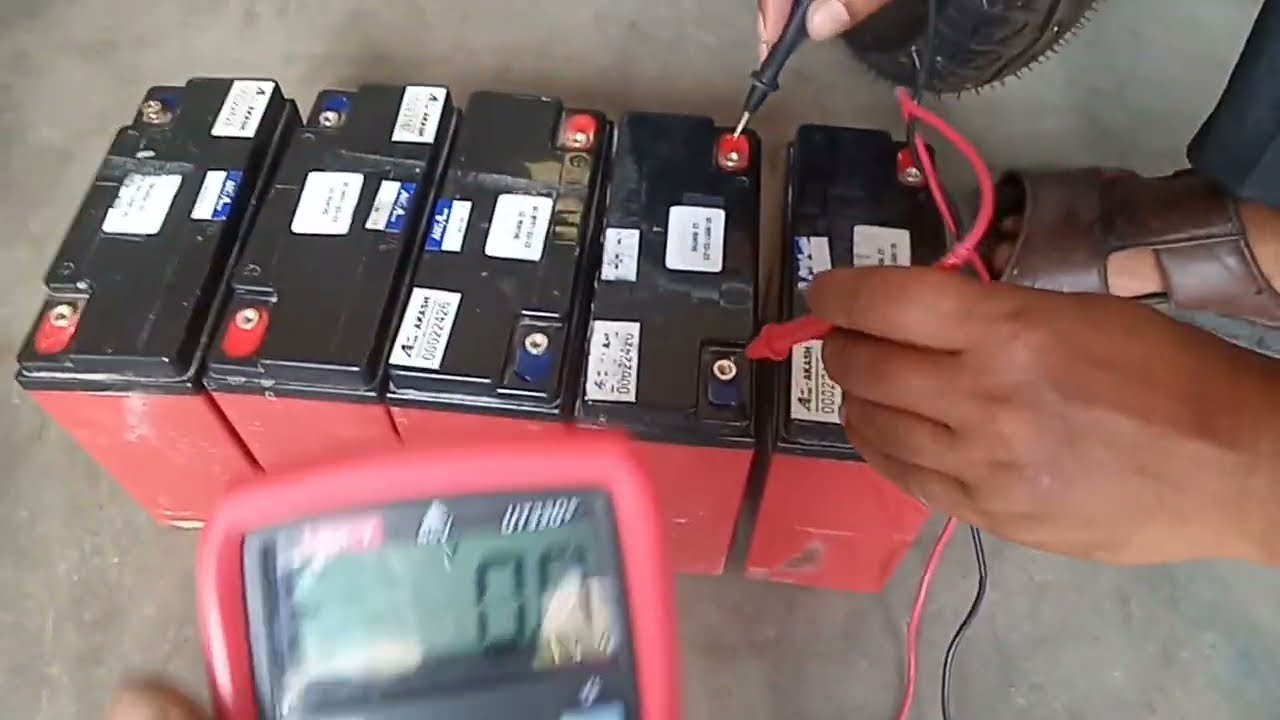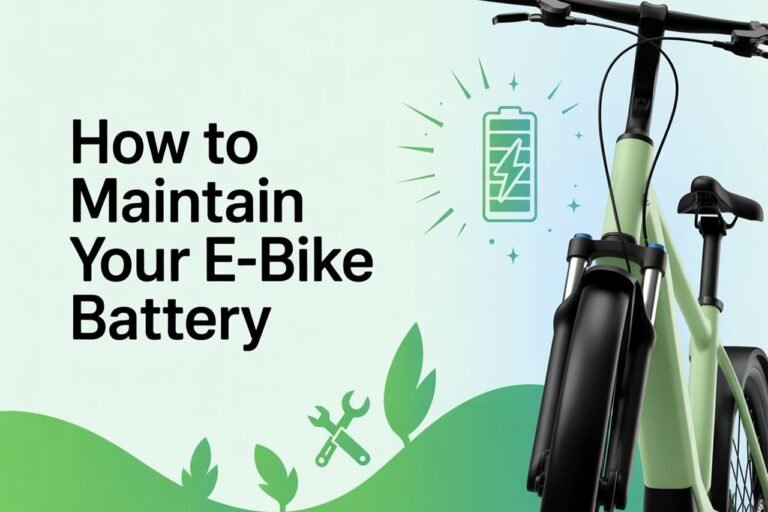
Your e-bike has been your trusty companion for countless rides, but lately, those long adventures are getting cut short. When your battery starts losing its punch, it’s time to consider a replacement.
Most e-bike batteries need replacement every 3-5 years or after 500-1000 charge cycles, depending on usage and care. Quality batteries from top brands can last several years with proper maintenance, but riders will notice reduced range as the battery reaches the end of its life cycle. The replacement process involves matching voltage and capacity specifications while ensuring compatibility with the bike’s electrical system.
This guide walks riders through spotting the warning signs of battery failure, selecting the perfect replacement, and handling the installation process. We’ll also share proven tips to help that new battery last as long as possible.
Signs Your E-Bike Battery Needs Replacement
Your electric bike battery won’t last forever, and recognizing the warning signs early can save you from getting stranded mid-ride. The most common indicators include shorter riding distances, charging problems, and visible damage to the battery pack.
Reduced Range and Frequent Recharging
The most obvious sign that an e-bike battery needs replacement is when riders notice their electric bike won’t go as far on a single charge. A healthy electric bike battery should maintain about 80% of its original range after 500-1000 charging cycles.
When the battery starts failing, riders might find themselves charging their e-bikes every day instead of every few days. The bike might only travel 15-20 miles when it used to go 40-50 miles on the same charge level.
Common range reduction symptoms:
- Battery drains from 100% to 50% within the first few miles
- Power cuts out unexpectedly during rides
- Battery indicator shows full charge but drops rapidly during use
- Need to use lower assistance levels to complete normal rides
Most e-bike batteries lose about 20% of their capacity after 2-4 years of regular use. If the range has dropped below 60% of the original distance, it’s time to consider battery replacement.
Difficulty Charging or Extended Charge Times
Charging problems often signal that an electric bike battery is reaching the end of its useful life. A healthy e-bike battery typically charges to full capacity within 3-6 hours, depending on the battery size and charger specifications.
When batteries start failing, they might take 8-12 hours to reach full charge, or they might not charge completely at all. Some riders notice their battery gets stuck at certain percentage levels, like 85% or 90%, and won’t charge further.
Warning signs during charging:
- Charger light stays red and never turns green
- Battery feels extremely hot during charging
- Charging stops and starts repeatedly
- Battery shows full charge but drops to 70% immediately when unplugged
Temperature issues during charging are particularly concerning. If the battery pack becomes too hot to touch or emits any unusual smells, riders should stop using it immediately and seek professional help.
Physical Damage and Error Messages
Visual inspection can reveal important clues about battery health. Cracks in the battery casing, swollen cells, or corrosion around the connection points indicate serious problems that require immediate attention.
Many modern electric bikes display error codes when the battery management system detects issues. These codes might appear on the bike’s display screen or through flashing LED patterns on the battery itself.
Physical damage to look for:
- Cracks or splits in the battery housing
- Swelling or bulging of individual battery cells
- White or green corrosion around metal contacts
- Loose or damaged charging port
Error messages vary by manufacturer, but common codes include battery temperature warnings, cell voltage imbalances, or communication failures between the battery and motor controller. Riders should consult their e-bike manual or contact the manufacturer when these errors appear consistently.
Water damage from riding in heavy rain or improper storage can also cause battery failure. If moisture has entered the battery compartment, the electrical components inside may corrode and stop working properly.
Choosing the Right Replacement Battery
Finding the perfect electric bike battery requires matching your bike’s specifications with a reliable power source. The right battery choice depends on compatibility, power requirements, and quality considerations.
Compatibility with Your Electric Bike
Before shopping for a replacement electric bike battery, riders need to identify their current battery’s specifications. Most electric bikes use proprietary battery designs that only work with specific models.
The easiest way to ensure compatibility is checking the original battery’s part number. This number appears on a label stuck to the battery case. Writing down this information prevents costly mistakes.
Some e-bike manufacturers use universal mounting systems. These bikes accept batteries from different brands as long as the voltage matches. However, most modern electric bikes require exact battery replacements.
Key compatibility factors to check:
- Battery mounting style (downtube, rear rack, or integrated)
- Connector type and pin configuration
- Physical dimensions and weight
- Original manufacturer specifications
Understanding Voltage and Capacity
Voltage determines how much power the motor receives, while capacity affects riding distance. Most electric bikes operate on 36V, 48V, or 52V systems.
Using the wrong voltage can damage the motor or controller. A 48V battery on a 36V system might fry the electronics. Going lower reduces performance significantly.
Battery capacity gets measured in amp-hours (Ah) or watt-hours (Wh). Higher numbers mean longer rides between charges. A 48V battery with 14Ah provides 672Wh of total energy.
Common e-bike battery specifications:
| Voltage | Capacity Range | Typical Range |
|---|---|---|
| 36V | 10-15Ah | 20-40 miles |
| 48V | 10-20Ah | 25-50 miles |
| 52V | 14-21Ah | 30-60 miles |
Trusted Brands and Warranty Considerations
Quality battery manufacturers offer longer warranties and better safety features. Cheap batteries from unknown brands often fail within months or pose fire risks.
Reputable e-bike battery brands include:
- Samsung and LG (cell manufacturers)
- Bosch and Shimano (complete systems)
- Reention and Hailong (replacement specialists)
Most quality batteries come with 12-24 month warranties. Some premium options extend coverage to three years. The warranty should cover manufacturing defects and capacity loss.
Buyers should avoid batteries without safety certifications. Look for UL, CE, or UN38.3 markings on the battery case. These certifications prove the battery meets safety standards for lithium-ion devices.
Types of E-Bike Batteries Explained
Modern electric bikes use three main battery technologies, each with distinct advantages and drawbacks. Lithium-ion batteries dominate today’s market with their lightweight design and long lifespan, while older nickel-cadmium and lead-acid options still serve specific purposes despite their limitations.
Lithium-Ion Batteries: The Modern Marvel
Lithium-ion battery technology has revolutionized the e-bike industry by delivering lighter, longer-lasting power solutions. These batteries have become the gold standard for electric bikes because they pack more energy into smaller packages.
Key advantages include:
- Weight reduction of 50-70% compared to lead-acid batteries
- Longer lifespan with 500-1000 charge cycles
- No memory effect issues
- Fast charging capabilities
Modern lithium-ion e-bike batteries typically range from 400-700 watt-hours of capacity. They maintain consistent power output throughout their discharge cycle, unlike older battery types that fade as they drain.
The main downside? Cost. Lithium-ion batteries can cost $300-800 to replace, making them a significant investment for budget-conscious riders.
Nickel-Cadmium Batteries: The Rugged Classic
Nickel-cadmium (NiCd) batteries were popular in early electric bikes due to their durability and ability to handle extreme temperatures. They can operate in conditions ranging from -40°F to 140°F without performance issues.
These batteries excel in demanding environments where reliability matters more than weight. They can withstand thousands of charge cycles if properly maintained and handle deep discharge cycles better than most alternatives.
Major drawbacks include:
- Heavy weight (2-3 times heavier than lithium-ion)
- Memory effect problems
- Environmental concerns due to cadmium toxicity
- Lower energy density
Most modern e-bike manufacturers have phased out NiCd batteries in favor of cleaner, lighter alternatives. They’re now primarily found in older models or specialized industrial applications.
Lead-Acid Batteries: The Old School Heavyweight
Lead-acid batteries represent the oldest rechargeable battery technology still used in some budget e-bikes. They’re incredibly affordable, with replacement costs often under $100, making them attractive for entry-level electric bikes.
These batteries are virtually bulletproof when it comes to abuse tolerance. They can handle overcharging, deep discharge, and rough handling that would destroy other battery types.
The trade-offs are significant. Lead-acid batteries weigh 40-60 pounds compared to 6-8 pounds for equivalent lithium-ion units. They also have shorter lifespans, typically lasting only 200-300 charge cycles.
Most riders find the weight penalty too severe for practical use. Carrying an extra 40 pounds makes pedaling without assistance nearly impossible.
The Memory Effect Demystified
The memory effect occurs when batteries “remember” partial discharge cycles and gradually lose capacity over time. This phenomenon primarily affects nickel-cadmium batteries and, to a lesser extent, older nickel-metal hydride units.
When a NiCd battery is repeatedly charged before being fully discharged, it begins to treat the partial discharge point as its new “empty” state. The battery essentially forgets it has additional capacity available.
Prevention strategies include:
- Fully discharging the battery monthly
- Using smart chargers that cycle the battery
- Avoiding frequent partial charges
Lithium-ion batteries don’t suffer from memory effect, which is another reason they’ve become the preferred choice for modern e-bikes. Riders can charge them at any level without worrying about long-term capacity loss.
Step-By-Step Battery Replacement Process
Replacing an electric bike battery involves four critical phases that ensure safety and proper function. Each step requires specific tools and careful attention to connection points and mounting systems.
Safety Precautions and Preparation
Safety comes first when handling electric bike battery systems. Users should always turn off the e-bike completely and remove the key before starting any work.
Wearing safety glasses protects eyes from potential sparks. Rubber gloves prevent electrical shock during the replacement process.
Essential tools needed:
- Phillips head screwdriver
- Flathead screwdriver
- Wire strippers
- Multimeter
- Clean cloth
The work area should be dry and well-lit. Metal jewelry like rings and watches must be removed to prevent accidental short circuits.
Check the new battery voltage matches the old one exactly. A 36V system requires a 36V replacement, while 48V systems need 48V batteries.
Removing the Old Battery
Most electric bikes use either removable battery packs or integrated mounting systems. Removable packs typically slide out after unlocking with a key.
For integrated batteries, locate the mounting screws on the frame. These are usually found on the downtube or rear rack area.
Carefully disconnect the main power cable first. The connector should pull apart easily without excessive force.
Remove any secondary connections like charging ports or display cables. Take photos of wire positions before disconnecting to help with installation later.
Unscrew the mounting brackets and lift out the old battery pack. Electric bike batteries weigh between 5-8 pounds, so maintain a firm grip throughout removal.
Installing the New Battery
Position the new e-bike battery in the same location as the old unit. The mounting holes should align perfectly with existing brackets.
Secure the battery with original screws, tightening them snug but not over-tight. Over-tightening can crack the battery casing or strip threads.
Connect the main power cable first, ensuring the connector clicks firmly into place. A loose connection causes power loss and potential damage.
Attach any secondary cables like charging ports or display connections. These typically use smaller connectors that only fit one way.
Double-check all connections are secure and no wires are pinched between the battery and frame. Pinched wires can cause shorts or connection failures.
Testing After Installation
Insert the key and turn on the electric bike system. The display should light up and show the battery charge level immediately.
Test the throttle or pedal assist functions at the lowest power setting first. The motor should engage smoothly without unusual noises or jerky movements.
Check the battery charge indicator matches the expected level for a new battery. Most new batteries arrive with 60-80% charge from the factory.
Take a short test ride in a safe area to verify all systems work properly. Monitor for any error codes or unusual behavior during the first few minutes of operation.
If everything functions normally, the battery replacement is complete and the electric bike is ready for regular use.
Battery Care Tips for Longevity
Taking care of your electric bike battery properly can double or even triple its lifespan. The three main areas to focus on are smart charging habits, keeping batteries at the right temperature, and checking them regularly for problems.
Charging Habits for Longer Life
Lithium-ion batteries last longest when riders avoid charging them to 100% every single time. The sweet spot is keeping the charge between 20% and 80% for daily rides.
Charging your e-bike battery to 100% occasionally won’t hurt it. But doing this every day puts extra stress on the cells. Think of it like eating cake – fine once in a while, but not great as a daily habit.
Here are the best charging practices:
- Charge after every few rides instead of after each short trip
- Unplug the charger once it reaches 80-90% for regular use
- Only charge to 100% before long rides or trips
- Avoid letting the battery drop below 10% regularly
Never leave your battery plugged in for days at a time. This keeps it at 100% charge, which creates heat and reduces the battery’s overall life span.
Most electric bike battery systems have built-in protection. But following these simple rules can add 1-2 years to your battery’s useful life.
Proper Storage and Temperature Control
Temperature control is huge for lithium-ion batteries in e-bikes. Extreme heat and cold both damage the internal chemistry and reduce how long the battery will last.
Store batteries between 32°F and 77°F when possible. Garages, basements, and indoor spaces work well. Avoid leaving batteries in hot cars, direct sunlight, or freezing sheds.
For long-term storage, charge the battery to about 50-60% first. This gives the cells enough power to maintain themselves without the stress of being completely full.
Cold weather reduces battery range by 20-40% temporarily. This is normal and the full capacity returns when temperatures warm up. But repeated freezing can cause permanent damage.
Hot weather above 85°F also hurts battery performance. If you live in a warm climate, try to charge your electric bike battery indoors where it’s cooler.
Routine Maintenance and Inspection
Checking your battery regularly helps catch small problems before they become expensive ones. Most issues show warning signs if you know what to look for.
Inspect the battery case monthly for cracks, dents, or swelling. Any physical damage can let moisture inside and cause the battery to fail. Swollen batteries are especially dangerous and need immediate replacement.
Clean the battery contacts every few months with a dry cloth. Dirt and corrosion on the metal connections reduce power flow and can cause charging problems.
Watch for these warning signs:
- Sudden drops in range or power
- Unusual heat during charging
- Error messages on your bike’s display
- Charging times that become much longer or shorter
Most electric bike batteries include a warranty of 2-3 years. Keep track of your purchase date and contact the manufacturer if you notice major performance drops within the warranty period.
Test your battery’s range every few months by taking the same route. This helps you notice gradual declines in performance that might indicate the battery needs replacement soon.
Final Thoughts

Replacing electric bike batteries doesn’t have to feel like rocket science. Armed with the right knowledge, riders can make smart choices that keep their bikes running smoothly.
The key factors to remember when shopping for a replacement battery:
- Voltage and capacity must match the bike’s requirements
- Physical dimensions need to fit the existing battery compartment
- Connector types should be compatible with the current system
- Brand reputation matters for safety and longevity
Most e-bike owners get 3-5 years from their original battery before needing a replacement. Signs like reduced range, longer charging times, or the battery not holding charge indicate it’s time for a new one.
Budget-conscious riders can often find refurbished options that work well. However, investing in a quality replacement battery from a reputable manufacturer usually pays off in the long run.
The installation process is typically straightforward for most e-bike models. Many riders can handle the swap themselves with basic tools and careful attention to the manufacturer’s instructions.
Remember that proper battery care extends lifespan significantly. Store batteries in moderate temperatures, avoid complete discharge cycles, and charge regularly even during off-seasons.








![How to Change Gears on a Bike: A Beginner’s Step-by-Step Guide [year] How to Change Gears on a Bike: A Beginner’s Step-by-Step Guide [year]](https://goebikelife.com/wp-content/uploads/2023/12/How-to-Change-Gears-on-a-Bike-for-Beginners-768x512.jpg)



